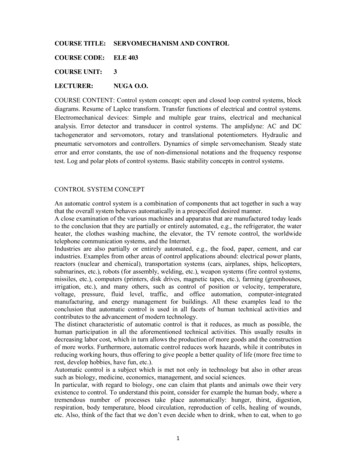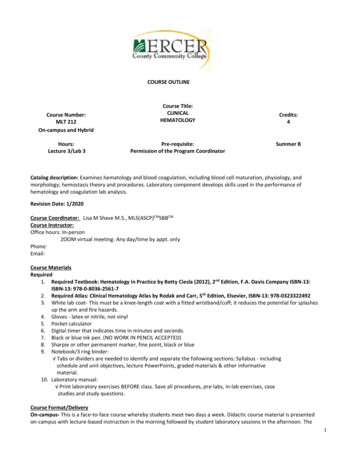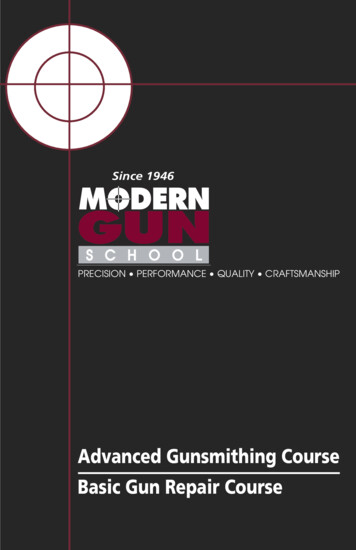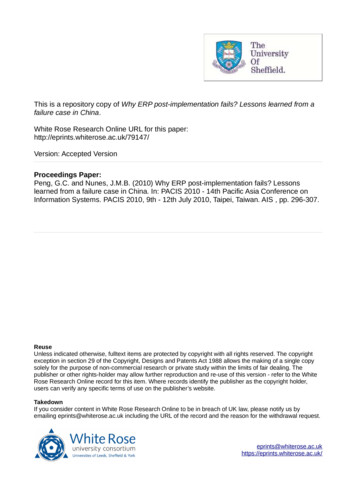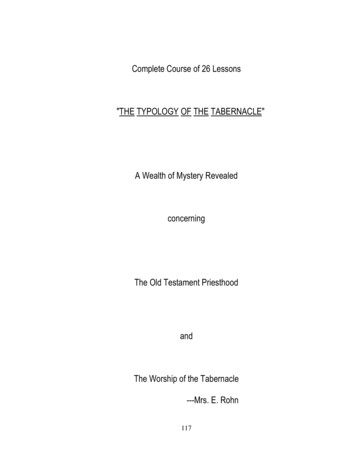
Transcription
Complete Course of 26 Lessons"THE TYPOLOGY OF THE TABERNACLE"A Wealth of Mystery RevealedconcerningThe Old Testament PriesthoodandThe Worship of the Tabernacle---Mrs. E. Rohn117
118
Lesson 64C.R.STUDIES ON THE TABERNACLE - IT'S PURPOSEIn the Tabernacle, we find one of the most interesting and profitable studies in all the Old Testament. It's importancecan some-what be appreciated when we consider that nearly twelve chapters in Exodus are given over to its description.The Lord cautioned Moses to make every detail exactly as He commanded, for each part was to represent some truthprecious to the heart of every believer. The two main purposes of the Tabernacle which we shall consider in the first lessonof this series, is that it fulfilled God's desire to dwell among His people, and it was given to furnish us with types and figuresto illustrate various phases of God's truth.I. GOD DESIRED TO DWELL AMONG HIS PEOPLE.A. The Lord clearly stated His own purpose in Ex. 25:8 when He said to Moses, "And let them make me a sanctuary, that Imay dwell among them." (The grace of God is exhibited at the very outset of our study for it was certainly His unmeritedfavor that made a holy God willing to dwell among a sinful people, and devise a plan whereby this might be made possible.)B. God's dwelling place among man takes on three aspects throughout the word of God, the first being typical of the othertwo:1. The Tabernacle in the wilderness, and the Temple of Solomon. The Temple of Solomon was built on the same plan as theTabernacle and contained the same articles of furniture, but was a permanent, in-stead of a temporary structure, and farexceeded the Tabernacle in glory and splendor. While Israel was on the march it was necessary that they have a buildingwhich could be carried easily from place to place. In Ex. 29:43, 45 is recorded God's promise to dwell with the children ofIsrael in the Tabernacle. In I Kings 8:15 Solomon makes a similar statement concerning the Temple: "I have surely built theean house to dwell in a sett1ed place for thee to abide in forever."2. God next dwelt among men in the person of His Son for 33 ½ years In John 1:14 we read that the Word (which was God,Jn. 1:1) was made flesh, and dwelt among us. The word, "dwelt," is in its literal meaning, "tabernacled." The human templeof Christ, then, was God's Tabernacle, His dwelling place among men. He was "the true tabernacle which God pitched, andnot man." Heb. 8:2. God's dwelling place was no longer to be a house of wood and gold, but a house of flesh and bones,the body of the Lord Jesus. Heb. 10:5. See also Col. 1:15, 19; Col. 2:8-9; 2 Cor. 5:19; John 14:9-10.3. God next dwelt in the Church, through the Holy Spirit given to each of its members. When the Tabernacle of the Sonascended into heaven (Acts 1:9) His followers were lonely, for God no longer dwelt among men. The Lord promised,however, before He went away, that He would not leave them thus, but would come to dwell in them: "For are the temple ofthe living God; as God hath said, I will dwell in them, and walk in them, and I will be their God and they shall be my people."2 Cor. 6:16. God's Spirit-filled people are now His "tabernacles." See Ps. 84:1. Also Jn. 14:16-17; 2 Cor. 5:1; Rom. 8:11.God will dwell among men in the person of the glorified Christ throughout the millennium, and all eternity.119
Jesus is seen dwelling in the midst of His people during the Millennium in the following scriptures: Zech. 2:10,11; Isa.32:1 and Jer. 23:5.That God will dwell with man throughout eternity in the person of the glorified Christ is seen in Rev. 7:15; Rev. 21:3,22;Rev. 22:4. Notice especially Rev. 21:3: "Behold the tabernacle of God is with men, and he will dwell with them, and theyshall be his people, and God him-self shall be with them, and be their God." In the 22nd verse this Tabernacle is spoken ofas "the Lord God Almighty and the Lamb." These terms apply to one person, for in Rev. 22:3-4, when John is describing "thethrone of God and of the Lamb" he is careful to say that they "shall see his face." (Singular).II. THE TABERNACLE FURNISHES TYPES OF CHRIST AND THE CHURCH.A. In the 9th chapter of Hebrews Paul refers to the worship con-ducted in the Tabernacle, and tells us that it "was afigure for the time then present." Vs. 9. In Heb. 9:24 he explains that Christ, the true High Priest "is not entered into the holyplaces made with hands, which are the figures of the true; but into heaven itself." We shall find in lessons to follow that theTabernacle was not only a type of the person of the Lord Jesus, but that each piece of furniture is an object lesson,describing some phase of Christ's work for man. See also Heb. 9:2-11; Heb. 10:1. That the Tabernacle and Temple areboth types of Jesus is clearly shown by a number of statements made in re-gard to the Temple in I Kings 8:27-50:(1) It was a house where God chose to place His name. Vs. 29. The body of Jesus was the temple where Jehovahplaced His name. See John 5:43: "I am come in my Father's name." That the Son of God was given God's own name, ismade plain when we realize that He obtained it by inheritance: "Being made so much better than the angels, as he hath byinheritance obtained a more excellent name than they."(2)Men were to pray toward the Temple. I Kings 8:30: "And hearken thou to the supplication of thy servant,and of thy people Israel, when they shall pray toward this place." This illustrates in type the fact that if we wish to find God,we must pray toward His pre-sent dwelling place, for we can only gain audience with God as we seek Him in and throughHis Son, Jesus Christ. "No man cometh unto the Father, but by me." John 14:6. It is in the "face of Jesus Christ" that webehold the "glory of God." 2 Cor. 4:6.(3) Although God dwelt in the Temple, all of God was not there. I Kings 8:27: "But will God indeed dwell on the earth?behold the heaven and heaven of heavens cannot contain thee; how much less this house that I have builded!" Although thefulness of the Godhead dwells in Jesus Christ (Col. 2:9), God is a Spirit, and fills the universe.B. The Tabernacle is also given as a type of God's plan of salvation. The sacrifices offered in the courtyard showed thatGod could not dwell in the midst of a sinful people, except on the grounds of blood atonement. In God's plan of salvation, nosinner can approach God except he acknowledge the blood of His Savior as an atonement for his sin. We shall alsoconsider in the following lessons a number of ways in which the Tabernacle typifies the Church, and its members.120
Lesson 64Dimensions:Court - 150 ft. X 75 ft.Tabernacle - 45 X 15 X 15 ft.Holy Place - 30 X 15 X 15 ft.Holy of Holies - 15 X 15 X 15 ft.Gate - 30 ft.THE TABERNACLE - AND OUTER COURTFurniture1. Brazen Altar2. Brazen Laver3. Table of Shewbread4. Golden Candlestick5. Alter of the Incense6. Ark of the CovenantSurrounding the Tabernacle was what was called the Court. It was an enclosure 150 by 75 feet, with an opening on theeastern side, called the Gate. All the people were allowed to come into this Court. The Courtyard fence was made of whitelinen, which hung from 60 pillars, twenty on each side, and ten on each end.Outside the Tabernacle in the Courtyard stood two important objects of ceremonial worship: the Brazen Altar, which was theplace of sacrifice for the sins of the people, and the Brazen Laver where the priests must wash before they could enter thesanctuary.The Tabernacle itself was an oblong building forty-five feet long, and fifteen feet wide and high. It was constructed of 48boards, covered with gold, and dropped into sockets of silver. These boards were held in place by horizontal bars, five oneach side. This building was divided into two unequal chambers, the Holy Place, and the Holy of Holies. The lattercontained the Ark of the Covenant, the lid of which was the Mercy-seat. The larger division, or Holy Place, contained theGolden Candlestick, the Table of Shewbread, and the golden Altar of In-cense. It was separated from the outer Court by acurtain of blue, purple and scarlet. These two chambers were divided by a magnificent curtain, called the Veil. This, in brief,describes the Tabernacle and the outer Court.121
Lesson 66ORDER OF THE CAMPI. ARRANGENT OF THE INNER CIRCLE.1. Outside the gate the Camp of Israel was arranged in the exact order given by the Lord. The inner circle was made upof the priests, who ministered in the sanctuary, and the workers, who took down, and put up the Tabernacle as theyjourneyed from place to place. Moses and Aaron and Aaron's sons were to camp on the east side, directly in front of theTabernacle. Num. 3:38. This is why the entrance into the Holy City is often spoken of as "the Eastern gate." Only thispriestly family could enter the sanctuary.2. The Levites were chosen from among the rest of the tribes to "do the service of the Tabernacle." Num. 3:6-13. The tribeof Levi consisted of the sons of Gershon, the sons of Kohath, and the sons of Meran. Num. 3:17. The Gershonites were tocamp on the west (Vs. 25), the Kohathites on the south (Vs. 29), and the Merarites on the north of the Tabernacle (Vs. 35).3. The Gershonites had charge of the coverings, hangings, curtains etc. Num. 3:25-26. They were carried with 2 wagonsand 4 oxen. Num. 7:7. The sons of Merari had charge of the framework. Num. 3:36,37. These were carried with 4 wagonsand 8 oxen. Num. 7:8. The sons of Kohath had charge of the furniture. Num. 3:31. All of these things were carried upontheir shoulders. Num. 7:9.II. ARRANGEMENT OF THE OUTER CIRCLE.1. Judah, Issachar, and Zebulon with their tribes camped on the east; the tribes of Reuben, Simeon, and Gad on the south;Ephraim, Menasseh, and Benjamin on the west; Dan, Asher, and Naphtali on the north. These were the soldiers, makingfour armies of three divisions each.2. One had to enter the court from the camp of Judah, which suggests to us the fact that Christ was born of the tribe ofJudah. Thus we enter into Christ's plan of salvation from coming in contact with Christ, the Lion of the tribe of Judah.III. THREE CLASSES OF PEOPLE.From this arrangement, we can see that the camp of Israel was divided into three classes of people: the priests, the workers,and the soldiers. Each Christian is confronted with three enemies: the World, the Flesh, and the Devil. However, hisdefense is also threefold, for each saint of God should be a Worker, a Warrior, and a Worshipper. Some Christians who loveto worship God, hesitate to step out in His service, while others are always doing things in the Master's vineyard, but keepso busy doing that they take little time for true worship and praise. That each saint should be a soldier, having on the wholearmor of God is shown in the following references: 2 Tim. 2:3, Eph. 6:13, I Tim. 1:18, 2 Cor. 10:3-5, and 2 Tim. 2:4. Soldiersmust not only be well equipped, but be willing to endure hardness, and not be entangled with the affairs of this life. God'speople are also workers, or servants: Rom. 1:1; I Cor. 9:19,20, and Gal. 5:13. As worshippers they are called priests ofGod, not only because they are to continually offer praise and adoration, but because they are to intercede for those whoare still out of the ark of safety. See Rev. 5:10 and Rev. 20:6. As priests and kings, we shall "reign on the earth.''122
Lesson 67THE PRESTHOODC.R.I. The tribe of Levi chosen for the Priesthood.1. The Priesthood carried on the ceremonies in the Tabernacle, set up, took down, and transported the Tabernacle. Num.3:6-8. The Levites were chosen instead of the firstborn, who had been set apart as holy unto the Lord, in memory of God'sprotection of them on the night of the Passover. Num. 3:12, 13; Ex. 22:29-30; Num. 8:17-18.A. Each Levite redeemed one of the firstborn. "Behold, I have taken the Levites from among the children of Israel instead ofall the firstborn." However, as there were 22,273 firstborn, and only 22,000 Levites, the remainder of the firstborn wereredeemed at the rate of five shekels each, which redemption money was given to the priests. Num. 3:43-51.B. This. is typical of Jesus, our Priest, redeeming each member of the Church, which is called "the church of the firstborn."Heb. 12:23 However, Peter reminds us that we were not redeemed with gold, such as some of them were, but with the bloodof Christ. I Pet. 1:18.2. No doubt this tribe was chosen for their stand on the Lord's side when the children of Israel were worshipping the goldencalf. Ex. 32:26. God always had a faithful few. As the Levites were rewarded for their bold stand against the sin of theirday, so will those today be rewarded for taking their stand for the Lord amid an unbelieving people. Our reward, like theirs,will be membership in a royal Priest-hood. See I Pet. 2:9.II. Purpose of all details being given by the Lord.The Tabernacle is the only building we read about in the Word of God, with the exception of Solomon's Temple, which hasthe Lord as its sole architect. God Himself arranged the order of the camp, and gave all the instructions as to how theworship should be carried on. He left no room for man to incorporate his own ideas into the plan, or choose his own place inthe body.1. This fact alone should prove that the worship of God, if it is to be accepted, must be carried on only as God directs, andnot as man may please to do it. See Heb. 8:5; Jude 3; Gal. 1:8; John 17:20; Matt. 10:19. Just as the pattern for OldTestament worship was given in the book of Exodus, so the Lord has given a pattern for New Testament worship in the bookof Acts. Jude exhorts that the Christian contend earnestly for the same faith that was delivered to the saints by the apostles,and Paul warns us not to preach any other gospel than that which he preached to the people.2. Each having his allotted place and duties, made order, and did away with confusion. If each member in the Church willallow the Holy Spirit to show him his place, the Chu
Complete Course of 26 Lessons "THE TYPOLOGY OF THE TABERNACLE " A Wealth of Mystery Revealed concerning The Old Testament Priesthood and The Worship of the Tabernacle ---Mrs. E. RohnFile Size: 717KBPage Count: 27






